
Trees and bushes: different habits
All prunings, all shapes, for all gardens
Contents
When landscaping a garden, many questions arise when choosing trees and bushes to form its framework. What size? Deciduous or evergreen? With or without flowers? With coloured foliage or not? And so on… But above all, which tree form, which habit, which tree silhouette can be adopted in my garden? Indeed, not everyone has several hectares available and after a while one realises that only trees and bushes with limited growth can be chosen. But sometimes people also want to select more unusual or original shapes or silhouettes: columnar, pyramidal, tabular, creeping… Let’s quickly review the different forms, silhouettes or habits of trees you can find in a nursery.
Trees, bushes and shrubs: some quick definitions
Gardeners, even professionals, tend to muddle terms. It must be recognised that distinctions between trees, bushes and shrubs are often rather blurred.
- A tree is a woody plant that has a large-diameter trunk, straight or not, and branches high up (the crown), and that reaches more than 7 metres at maturity such as beech.
- A bush is a woody plant that has a small-diameter trunk, straight or not, branches high up and which measures from 2 to 7 metres in height at maturity such as peach tree.
- A shrub is a woody plant that measures between 50 cm and 2 metres, that does not have a trunk and branches from the base like hazel.
- An undershrub, meanwhile, will not exceed 50 centimetres at maturity.
Needless to say, as gardeners we tend to call anything growing on a single trunk a tree and anything that forms more or less a clump from the base a bush.
Warning: some trees can be coppiced and therefore present several trunks from the base!
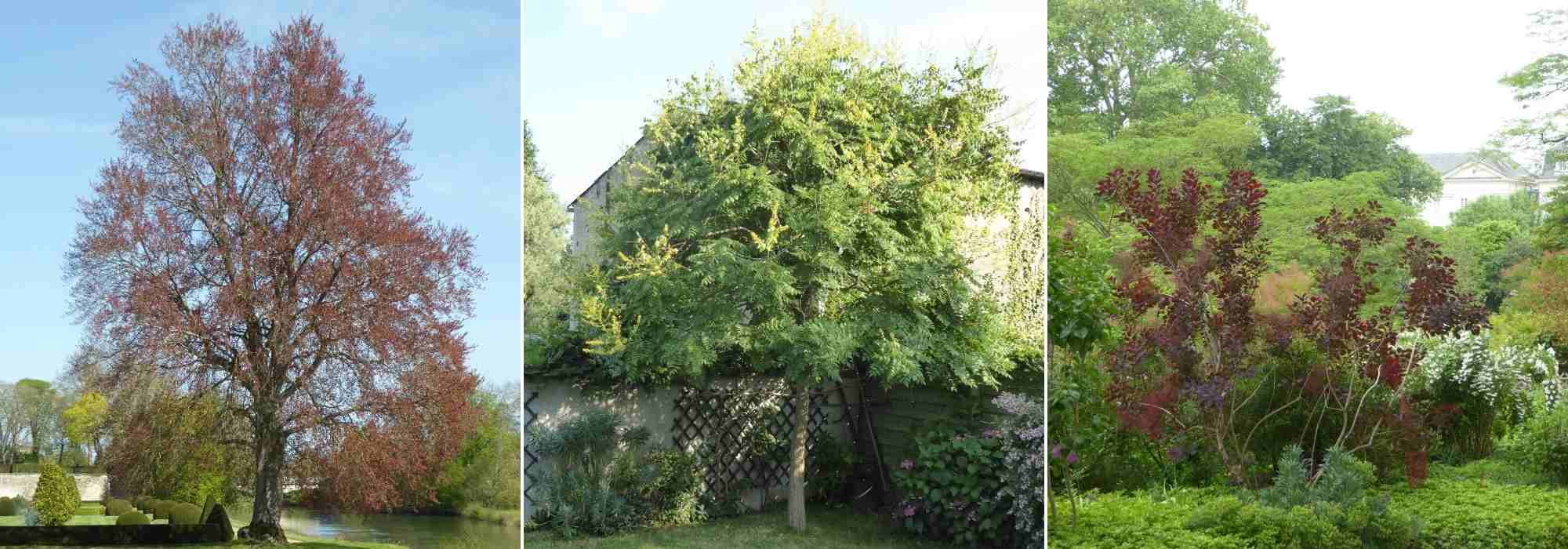
A copper beech, a golden rain tree and a Cotinus: three distinct heights and habits of tree, bush and shrub, for spaces of different sizes (Photos : Gwenaëlle David)
Read also
7 trees for small gardensConical and pyramidal habit
Ideal planted singly or inserted into beds of flowering bushes, shrubs and perennials, or in large mixed hedges, trees and bushes with conical or pyramidal habit have branches arranged laterally, decreasing in size from base to crown, creating a geometrically conical, regular silhouette as with Liquidambar styraciflua or a more slender, conical habit as with Cercidiphyllum japonicum, for example. But this is also true for many conifers such as firs, spruces or Himalayan pine.
Some naturally round out over the years but, to maintain a conical silhouette, you will probably need to cut any branch that becomes too vigorous and would deform the outline. The terminal shoot (the tip of the pyramid) must always remain dominant or the conical appearance will be lost.
There are trees of conical or pyramidal habit in all sizes. The largest should be avoided in small gardens, but many varieties more compact than type species are now available.
Examples of trees with conical habit: Cercidiphyllum japonicum, Metasequoia glyptostroboides, Corylus colurna…
Examples of trees with pyramidal habit: Liquidambar styraciflua, Magnolia grandiflora, Gingko biloba, Tillia cordata…
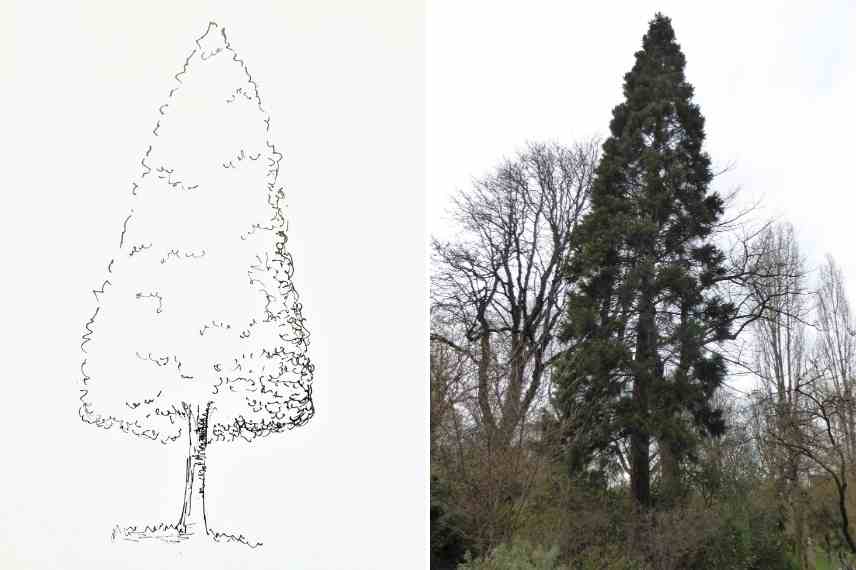
Conical habit recognisable by its slender, triangular outline. On the right, a Sequoia (Sketch and photo: Gwenaëlle David)
Discover other Shrubs by variety
View all →Available in 1 sizes
Available in 1 sizes
Available in 1 sizes
Available in 1 sizes
Available in 1 sizes
Available in 1 sizes
Available in 1 sizes
Available in 1 sizes
Available in 1 sizes
Available in 1 sizes
Columnar and fastigiate habit
People often confuse “columnar habit” and “fastigiate habit“. Both types of habit have a crown taller than wide but trees with a columnar habit have rather horizontal secondary branches while trees with a fastigiate habit have erect branches almost vertical and held close to the trunk.
Plant this type of tree as a “vertical” focal point in beds of low flowering plants or at regular intervals in mixed hedges, mixed with trees or bushes with more “airy” or weeping silhouettes. Trees and bushes with a fastigiate or columnar habit have a particularly conspicuous form, forming a narrow, slender vascular bundle. Do not crowd them too closely to avoid losing this very graphic appearance. Growth is entirely upward and they can therefore reach several metres in height while typically not exceeding about 2 metres in width on average, sometimes less for trees with a fastigiate habit and about 4 metres wide for trees with a columnar habit.
They can also mark an access path, an avenue leading from entrance gate to house and give a Mediterranean or classical touch to your garden.
They draw the eye and give the impression that garden is longer or wider depending on whether they are placed at back or around garden. Finally, they are ideal in small gardens of a few ares because they take up little horizontal space.
Some examples of trees with a columnar habit: Calocedrus decurens, Malus trilobata or Gleditsia triacanthos ‘Elegantissima’.
Some examples of trees with a fastigiate habit: Betula pendula ‘Fastigiata’, Prunus serrulata ‘Amanogawa’, Rhamnus frangula ‘fastigiata’ or Cephalotaxus harringtonia ‘Fastigiata’. Some larger trees also have a fastigiate habit with a spread of nearly 6 metres after a few years: Fagus sylvatica ‘Dawyck’ or Populus nigra ‘Italica’.
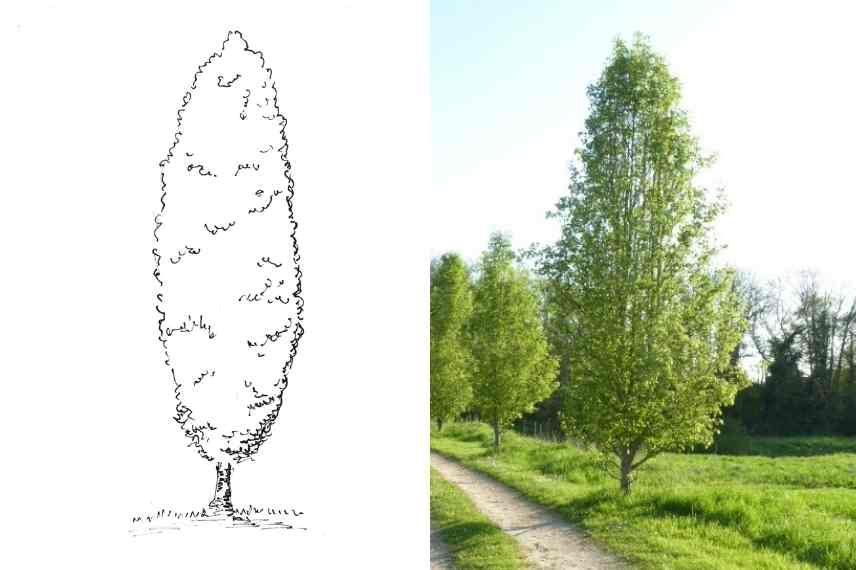
Fastigiate habit, and on right, an avenue of Pyrus fastigiates (Sketch and photo: Gwenaëlle David)
→ Find out more with 7 bushes with a columnar habit and 10 trees with a columnar habit
Spreading habit
Perfect companions for enjoying a nap in their shade, trees and bushes with a spreading habit have branches that grow horizontally from a fairly low trunk. They are ideal planted alone in the centre of a short grass meadow or in small groups to form a little grove in the middle of a meadow or in a park. You should remove the lowest branches quickly for two reasons: to be able to move “easily” underneath and to achieve a pleasing “parasol” effect from your tree. Pruning to transparency of the main trunk(s) will further accentuate the aesthetic of this type of tree.
Their spreading can sometimes cause problems in small gardens, especially if planted close to buildings or at the garden edge. Indeed, even when heavily pruned, these trees quickly regain their natural habit. The ideal is therefore to allow enough width from the start. Make sure you check in advance the size of your mature trees!
However, some trees adopt a so-called “parasol” habit that produces spreading branches on a fairly high trunk. These are also trees to reserve for fairly large gardens, in the centre of a large short grass meadow or at the edge of a park.
Some examples of trees with a spreading habit: Catalpa speciosa, Parrotia persica, certain Prunus such as Prunus serrulata ‘Accolade’, snake-bark maples or mulberries such as Morus kagayamae.
Some examples of trees with a parasol habit: Albizzia jubrissin or umbrella pine.
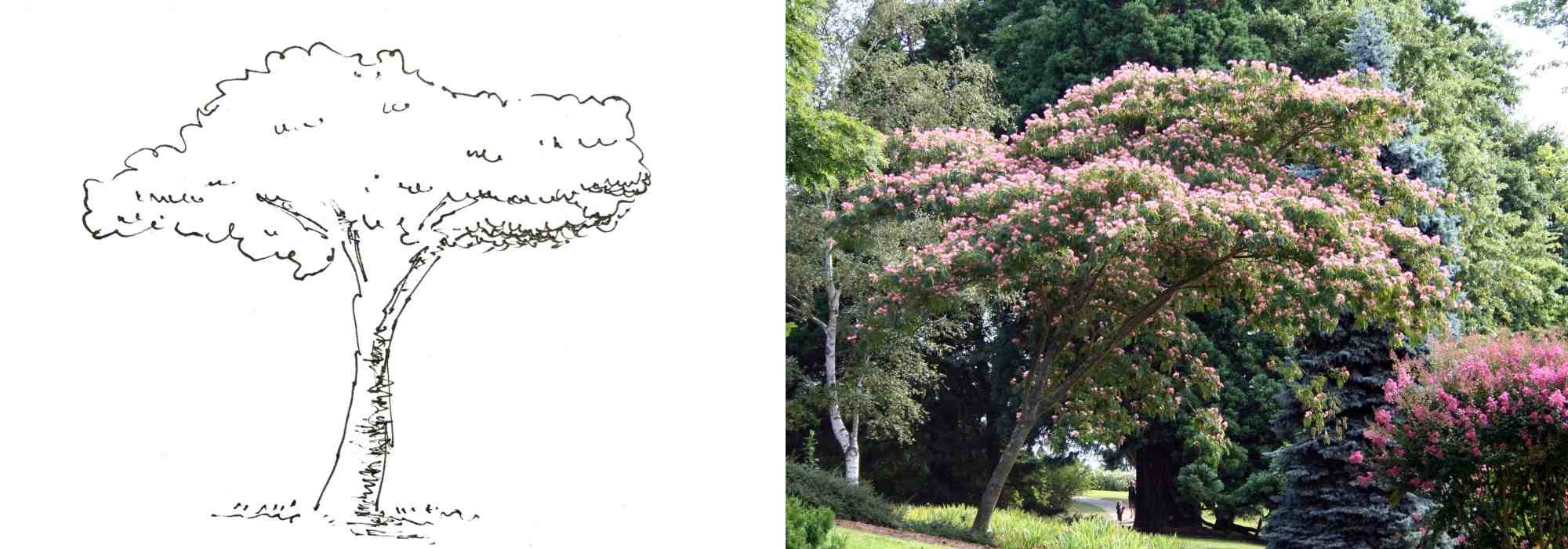
Typical silhouette of parasol habit. On the right an Albizzia julibrissin (Sketch Gwenaëlle David)
Creeping habit
Placed on barren slopes, at the foot of more majestic trees and bushes, the trees and bushes with a creeping habit have branches lying on the soil from birth. This is due to an adaptation to harsh, windy and snowy climates, often montane.
They will cover and protect the soil while keeping some moisture and preventing emergence of adventive plants. They can therefore act as groundcover but also help stabilise slopes. As they are by definition trees that grow very low and spread over time, they are ideal in any garden, from smallest garden to parks of several hectares.
Some examples of trees with a creeping habit: Pinus mugo, creeping willow (Salix repens) or dwarf juniper (Juniperus sibirica)…
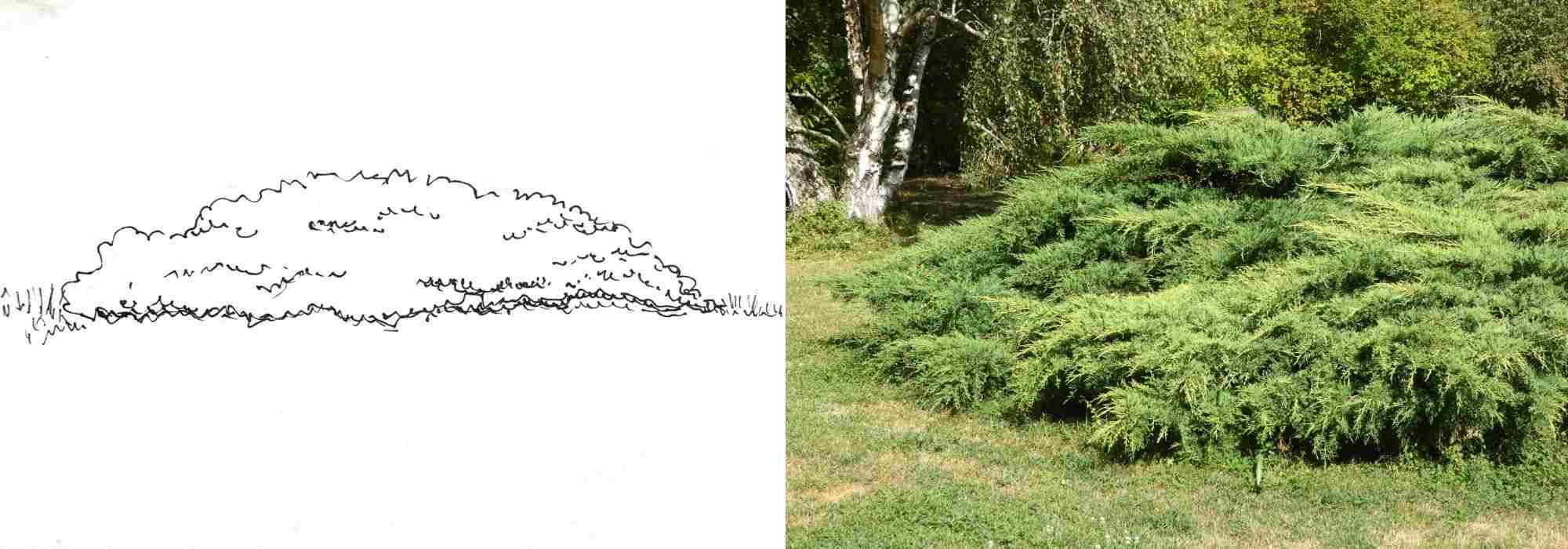
Flat silhouette of creeping habit. On the right, a Juniperus (Sketch and photo: Gwenaëlle David)
Weeping habit
Weeping-habit trees have supple branches that hang down and naturally grow towards the ground. They can be planted at the water’s edge like a weeping willow (Salix babylonica) or planted singly or in a grove in the middle of a meadow or short grass meadow, for example a weeping cedar or weeping birches.
Weeping-habit trees are plants generally more suited to large gardens. However note that there are horticultural varieties suitable for small gardens, such as the fastigiate weeping birch or Betula pendula ‘Fastigiata’, which is a weeping tree with a fastigiate habit and therefore very narrow. One can also find trees with pendulous branches that are not strictly weeping, as in the case of the China fir (Cunninghamia lanceolata).
Some examples of weeping-habit trees not exceeding 6 m with a spread of about 5 m: Pyrus salicifolia ‘Pendula’, Salix caprea ‘Pendula’ or Sophora japonica ‘Pendula’.
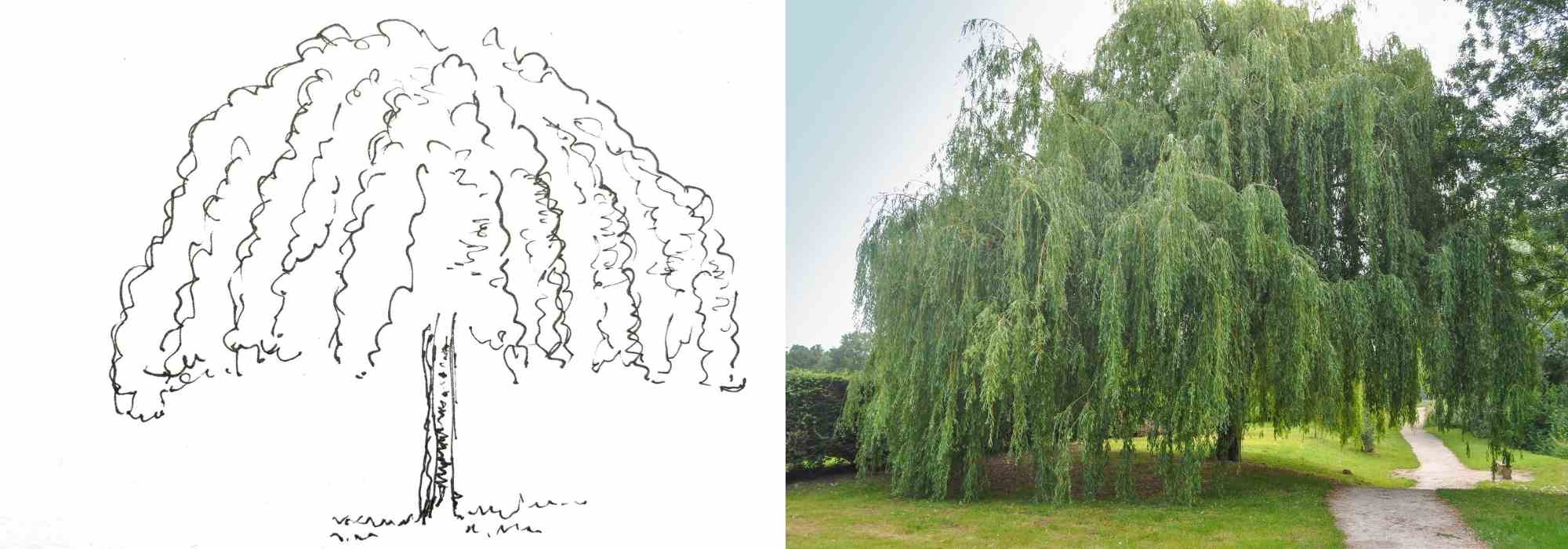
Recognisable habit of a weeping tree (Sketch: Gwenaëlle David). On the right, a weeping willow (Salix babylonica)
→ Discover the weeping-habit trees
Some special cases...
- Tabular habit: reserved for large gardens to appreciate their particular habit. Mostly found among conifers such as Araucaria araucana, whose branches are arranged in rings around the trunk (or whorled habit) forming tiers. But tabular habit is also found in some deciduous trees such as Cornus controversa and Cornus alternifolia. Note that the latter can, however, be easily integrated into a small garden ;
- Bushy or irregular habit: plant forms a bush with an irregular shape. Bushy habit is mainly seen in bushes. This habit is characterised by shoots of the main branches from the base while the lateral shoots are more vigorous than those lower down. Small bushy bushes are ideal for slightly wild informal hedges ;
- Ball or spherical habit: these generally remain fairly small and therefore suit confined spaces. In addition, they do not require particular pruning ;
- Ovoid or globose habit: examples such as Robinia pseudoacacia ‘Umbraculifera’ or Acer platanoides ‘Globosum’ pair perfectly with trees or bushes with broad, supple habits or with topiary to create a mounded effect, for example with box or Ilex crenata ;
- Twisted habit: branches of trees and bushes twist in all directions as in corkscrew willow or contorted hazel. As with trees and bushes with decorative bark, they deserve a place as specimens or in beds of shrubs or perennials. They can be placed in front of hedges of evergreen-leaved plants so their distinctive silhouettes are highlighted even during winter.
- Particular case of the stipe: this is not strictly speaking a tree habit. A stipe is simply a stem, a false trunk, which becomes lignified little by little or is formed of old dead leaves or fronds. A stipe is found in palms, yuccas, banana plants or arborescent ferns.
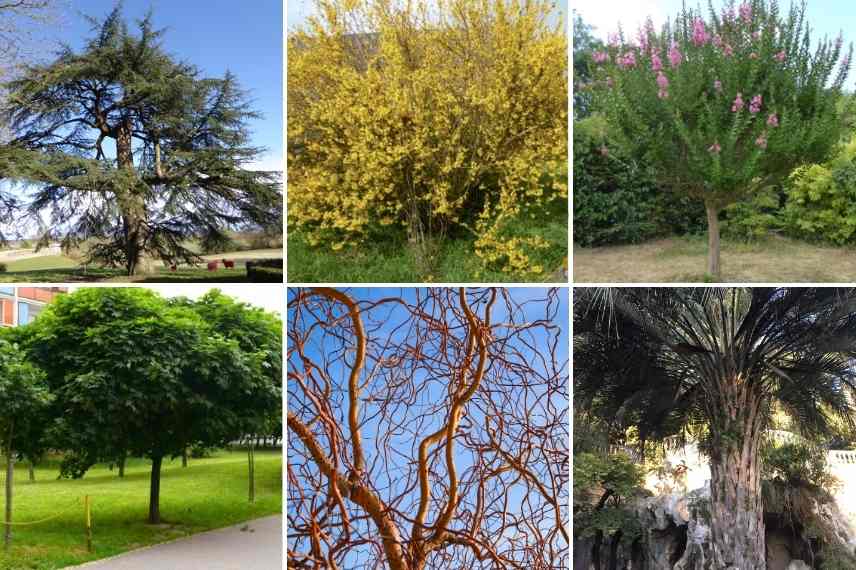
Typical tabular habit of Cedar, bushy habit of a Forsythia, ball habit of a Lagerstroemia, globose habit of Acer platanoides ‘Globosum’, twisted habit of Salix tortuosa, and characteristic stipe of palm Butia capitata (Photos: Gwenaëlle David)
- Subscribe!
- Contents
































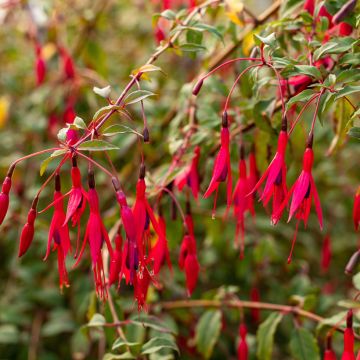

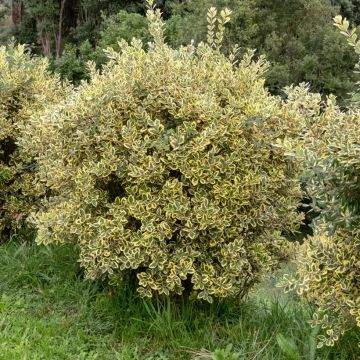

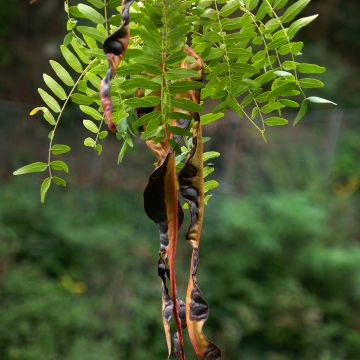


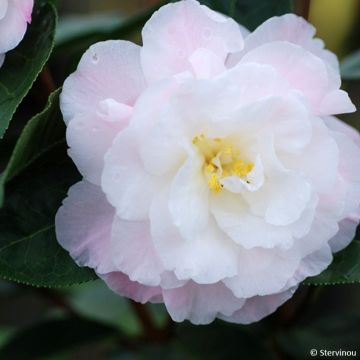

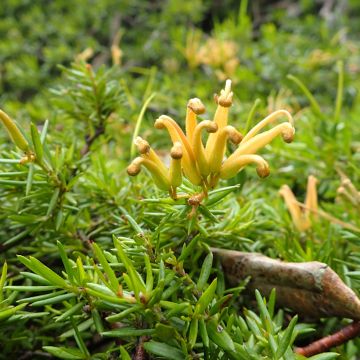
Comments